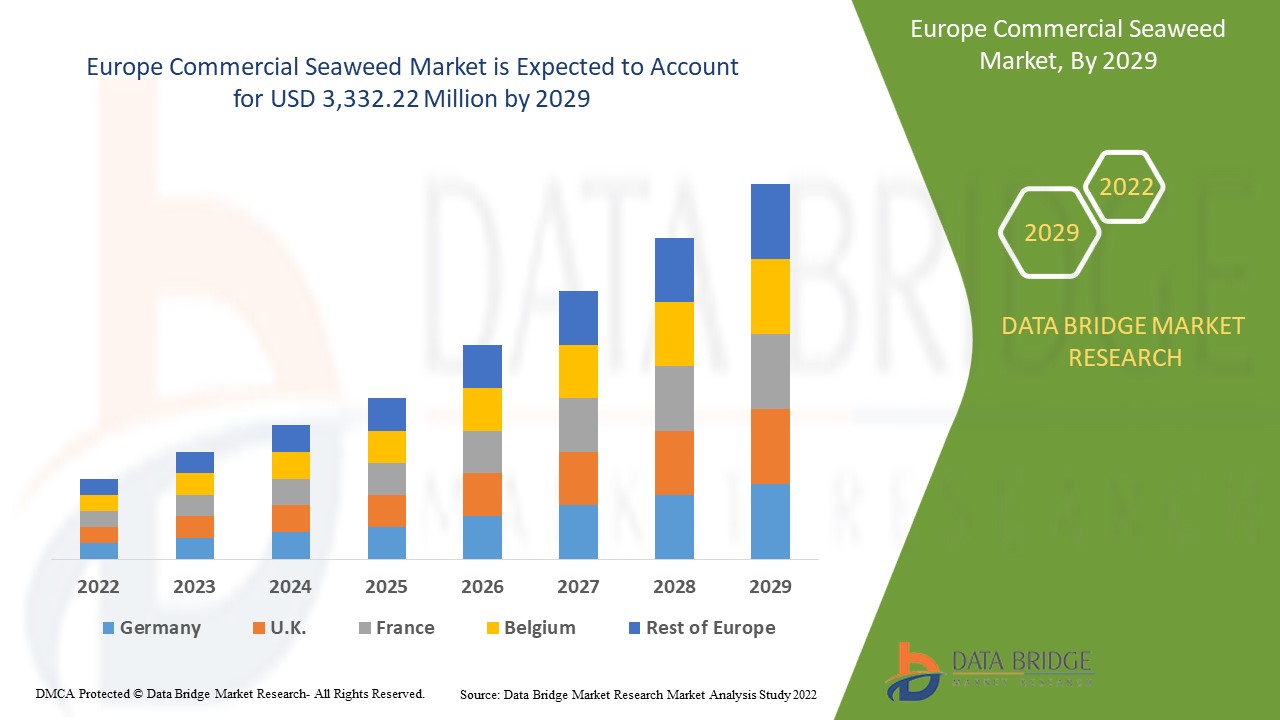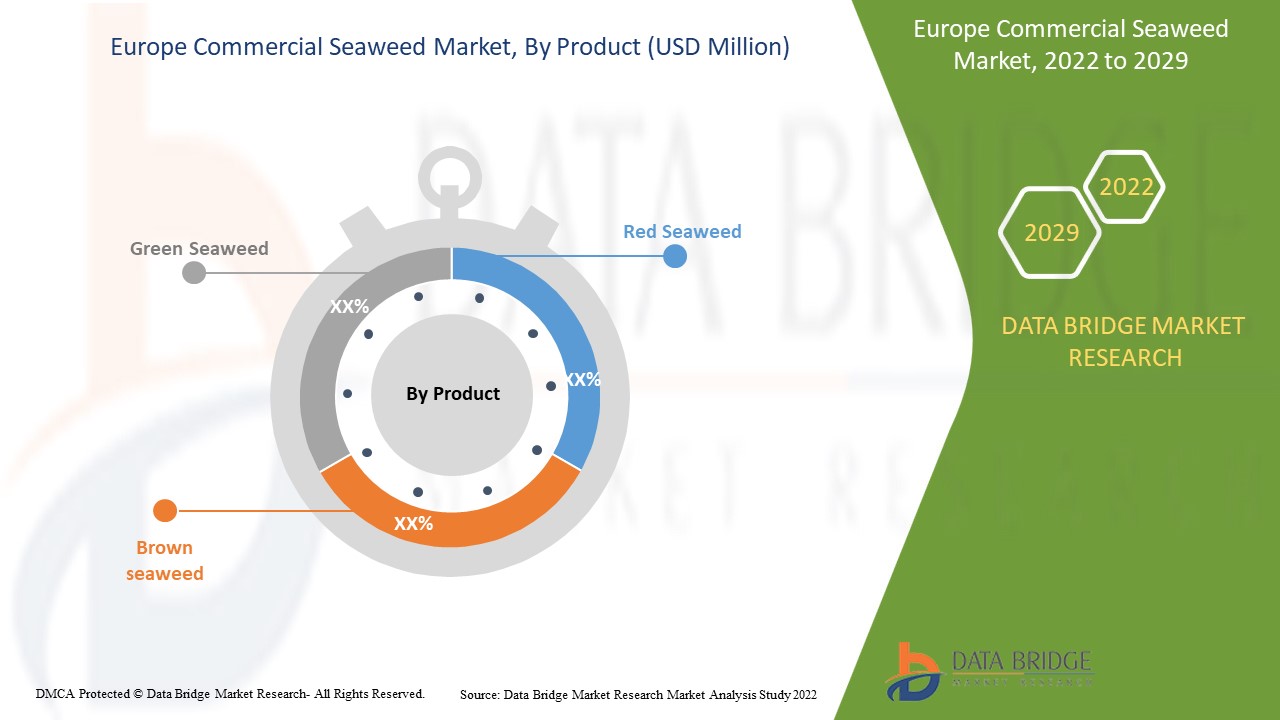Europe Commercial Seaweed Market, By Product (Red Seaweed, Brown Seaweed, Green Seaweed), Form (Liquid, Powdered, Flakes), Cultivation (Onshore Cultivation, Offshore Cultivation, Nearshore Cultivation, IMTA Cultivation, Saline Aquaculture), End-User (Food & Beverages, Pharmaceuticals, Agriculture, Animal Feed, Cosmetics & Personal Care, Biofuels, and Others), Country (France, U.K., Germany, Italy, Switzerland, Denmark, Norway, Russia, Spain, Netherlands, Belgium and Rest of Europe) Industry Trends and Forecast to 2029

Market Analysis and Insights: Europe Commercial Seaweed Market

The Europe commercial seaweed market is expected to gain market growth in the forecast period of 2022 to 2029. Data Bridge Market Research analyses that the market is growing with a CAGR of 6.3% in the forecast period of 2022 to 2029 and is expected to reach USD 3,332.22 million by 2029. The demand for commercial seaweed is high; hence revenue generation is also high, which may help the market grow in the region.
Commercial seaweed is the microalgae that grow in the sea, irrespective of marine water or freshwater. They are the food source for life in the ocean and can be found in three colors red seaweed, green seaweed, and brown seaweed based on the pigments present. Seaweeds grow mostly along the rocky shorelines all around the world. Commercial seaweed is an enriched source of proteins, vitamins, minerals, fibers, iodine, and antioxidants. Additionally, commercial seaweed is known to provide health benefits such as decreasing the risk of heart disease, diabetes, and goiter and improving gut health.
Commercial seaweeds are majorly famous for their hydrocolloids and have a wide application in various industries such as food & beverages, agriculture, animal feed, cosmetics & personal care, and pharmaceuticals.
The commercial seaweed market is expected to grow tremendously in Europe as commercial seaweeds are majorly famous for the hydrocolloids and have a wide application in various industries such as food & beverages, agriculture, cosmetics & personal care, and pharmaceuticals. However, the environmental risk associated with the seaweed and the high amount of iodine and heavy metals present is expected to restrain the market growth. Emerging applications of seaweed in various industries may provide opportunities in the market, and high seaweed prices may challenge market growth.
This Europe commercial seaweed market report provides details of market share, new developments, and product pipeline analysis, the impact of domestic and localized market players, analyses opportunities in terms of emerging revenue pockets, changes in market regulations, product approvals, strategic decisions, product launches, geographical expansions, and technological innovations in the market. To understand the analysis and the market scenario, contact us for an Analyst Brief; our team will help you create a revenue impact solution to achieve your desired goal.

Europe Commercial Seaweed Market Scope and Market Size

The Europe commercial seaweed market is segmented into four notable segments based on product, form, cultivation, end-user. The growth among segments helps you analyze niche pockets of growth and strategies to approach the market and determine your core application areas and the difference in your target markets.
- On the basis of product, the Europe commercial seaweed market is segmented into red seaweed, green seaweed, and brown seaweed. In 2022, the red seaweed segment is expected to grow due to the growing information about the health benefits of red seaweed in the region.
- On the basis of form, the Europe commercial seaweed market is segmented into liquid, powdered, and flakes. In 2022, the powdered segment is expected to grow owing to the easy availability of powder forms of seaweed in the region.
- On the basis of cultivation, the Europe commercial seaweed market is segmented into onshore cultivation, offshore cultivation, nearshore cultivation, IMTA cultivation, saline aquaculture. In 2022, the offshore cultivation segment has the largest market share due to the growing interest in cultivating seaweed in offshore cultivation, which allows growing seaweed on a larger scale.
- On the basis of end-user, the Europe commercial seaweed market is segmented into food & beverages, pharmaceuticals, agriculture, animal feed, cosmetics & personal care, biofuels, and others. In 2022, the food & beverages segment is expected to have the largest market share due to the growing application of seaweed in various food and beverage commodities.
Europe Commercial Seaweed Market Country Level Analysis
The Europe commercial seaweed market is analyzed, and market size information is provided by country, product type, form, cultivation, end-user.
The countries covered in the Europe commercial seaweed market report are France, the U.K., Germany, Italy, Switzerland, Denmark, Norway, Russia, Spain, Netherlands, Belgium, and the Rest of Europe.
France is expected to have the highest market share as growing cultivation of the seaweed and increase in demand of the seaweed across the end-users are fuelling the growth. The U.K is expected to grow because of the increase in the adoption of seaweed for hydrocolloids. Germany is projected to grow in the market because of growing awareness about the high nutritional value and health benefits of the seaweeds
The country section of the Europe commercial seaweed market report also provides individual market impacting factors and changes in market regulation that impact the current and future trends of the market. Data points such as new sales, replacement sales, country demographics, regulatory acts, and import-export tariffs are some of the major pointers used to forecast the market scenario for individual countries. Also, the presence and availability of European brands and their challenges faced due to large or scarce competition from local and domestic brands, the impact of sales channels are considered while providing forecast analysis of the country data.
Rising Applications of Commercial Seaweed in Various End Industry
The Europe commercial seaweed market also provides you with detailed market analysis for every country's growth in the industry with sales, components sales, the impact of technological development, and changes in regulatory scenarios with their support for the Europe commercial seaweed market. The data is available for historic period 2011 to 2019.
Competitive Landscape and Europe Commercial Seaweed Market Share Analysis
The Europe commercial seaweed market competitive landscape provides details by the competitor. Details included are company overview, company financials, revenue generated, market potential, investment in research and development, new market initiatives, North America presence, production sites and facilities, company strengths and weaknesses, product launch, product trials pipelines, product approvals, patents, product width and breadth, application dominance, technology lifeline curve. The above data points are only related to the companies' focus on the Europe commercial seaweed market.
Some of the major players covered in the report are Wild Irish Seaweeds, Cargill, Incorporated, Shore Seaweed, Marcel Carrageenan, AtSeaNova, Irish Seaweed, Organic Irish Seaweed-Emerald Isle, The Seaweed Company, MARA SEAWEED, Kai Ho "Oceans Treasure," Raw Seaweeds, Aushadh Limited., BY VIET DELTA, Ocean Rainforest, ALGOLESKO, Seaweed Solutions AS, and others. DBMR analysts understand competitive strengths and provide competitive analysis for each competitor separately.
For instance,
- In May 2018, Marcel Carrageenan announced the acquisition of Cebu Carrageenan plat from CP Kelco, known for producing specialty hydrocolloid ingredients. This acquisition has helped Marcel Carrageenan to increase its business and to expand its product portfolio
SKU-

